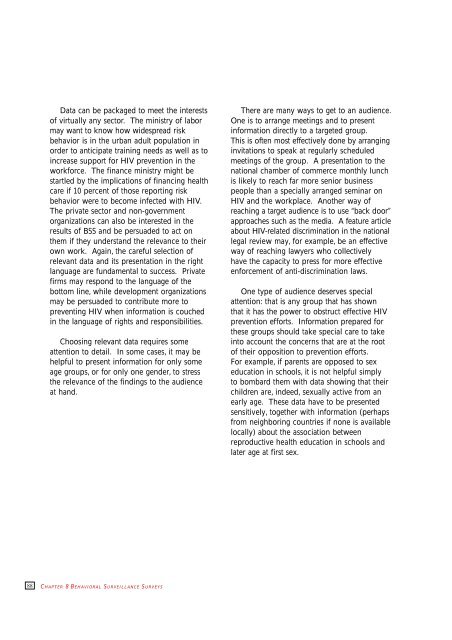Behavioural Surveillance Surveys - The Wisdom of Whores
Behavioural Surveillance Surveys - The Wisdom of Whores
Behavioural Surveillance Surveys - The Wisdom of Whores
You also want an ePaper? Increase the reach of your titles
YUMPU automatically turns print PDFs into web optimized ePapers that Google loves.
Data can be packaged to meet the interests<br />
<strong>of</strong> virtually any sector. <strong>The</strong> ministry <strong>of</strong> labor<br />
may want to know how widespread risk<br />
behavior is in the urban adult population in<br />
order to anticipate training needs as well as to<br />
increase support for HIV prevention in the<br />
workforce. <strong>The</strong> finance ministry might be<br />
startled by the implications <strong>of</strong> financing health<br />
care if 10 percent <strong>of</strong> those reporting risk<br />
behavior were to become infected with HIV.<br />
<strong>The</strong> private sector and non-government<br />
organizations can also be interested in the<br />
results <strong>of</strong> BSS and be persuaded to act on<br />
them if they understand the relevance to their<br />
own work. Again, the careful selection <strong>of</strong><br />
relevant data and its presentation in the right<br />
language are fundamental to success. Private<br />
firms may respond to the language <strong>of</strong> the<br />
bottom line, while development organizations<br />
may be persuaded to contribute more to<br />
preventing HIV when information is couched<br />
in the language <strong>of</strong> rights and responsibilities.<br />
Choosing relevant data requires some<br />
attention to detail. In some cases, it may be<br />
helpful to present information for only some<br />
age groups, or for only one gender, to stress<br />
the relevance <strong>of</strong> the findings to the audience<br />
at hand.<br />
<strong>The</strong>re are many ways to get to an audience.<br />
One is to arrange meetings and to present<br />
information directly to a targeted group.<br />
This is <strong>of</strong>ten most effectively done by arranging<br />
invitations to speak at regularly scheduled<br />
meetings <strong>of</strong> the group. A presentation to the<br />
national chamber <strong>of</strong> commerce monthly lunch<br />
is likely to reach far more senior business<br />
people than a specially arranged seminar on<br />
HIV and the workplace. Another way <strong>of</strong><br />
reaching a target audience is to use “back door”<br />
approaches such as the media. A feature article<br />
about HIV-related discrimination in the national<br />
legal review may, for example, be an effective<br />
way <strong>of</strong> reaching lawyers who collectively<br />
have the capacity to press for more effective<br />
enforcement <strong>of</strong> anti-discrimination laws.<br />
One type <strong>of</strong> audience deserves special<br />
attention: that is any group that has shown<br />
that it has the power to obstruct effective HIV<br />
prevention efforts. Information prepared for<br />
these groups should take special care to take<br />
into account the concerns that are at the root<br />
<strong>of</strong> their opposition to prevention efforts.<br />
For example, if parents are opposed to sex<br />
education in schools, it is not helpful simply<br />
to bombard them with data showing that their<br />
children are, indeed, sexually active from an<br />
early age. <strong>The</strong>se data have to be presented<br />
sensitively, together with information (perhaps<br />
from neighboring countries if none is available<br />
locally) about the association between<br />
reproductive health education in schools and<br />
later age at first sex.<br />
88<br />
C H A PTER 8 B EHAV I OR A L S U R V EI L L A NC E S U R V EY S










